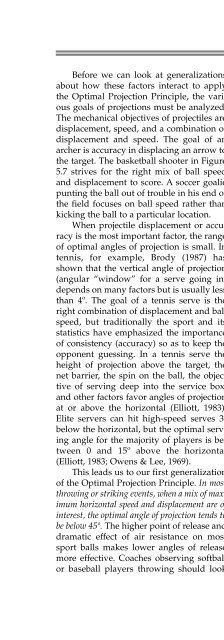Fundamentals of Biomechanics
Fundamentals of Biomechanics
Fundamentals of Biomechanics
You also want an ePaper? Increase the reach of your titles
YUMPU automatically turns print PDFs into web optimized ePapers that Google loves.
Before we can look at generalizations<br />
about how these factors interact to apply<br />
the Optimal Projection Principle, the various<br />
goals <strong>of</strong> projections must be analyzed.<br />
The mechanical objectives <strong>of</strong> projectiles are<br />
displacement, speed, and a combination <strong>of</strong><br />
displacement and speed. The goal <strong>of</strong> an<br />
archer is accuracy in displacing an arrow to<br />
the target. The basketball shooter in Figure<br />
5.7 strives for the right mix <strong>of</strong> ball speed<br />
and displacement to score. A soccer goalie<br />
punting the ball out <strong>of</strong> trouble in his end <strong>of</strong><br />
the field focuses on ball speed rather than<br />
kicking the ball to a particular location.<br />
When projectile displacement or accuracy<br />
is the most important factor, the range<br />
<strong>of</strong> optimal angles <strong>of</strong> projection is small. In<br />
tennis, for example, Brody (1987) has<br />
shown that the vertical angle <strong>of</strong> projection<br />
(angular “window” for a serve going in)<br />
depends on many factors but is usually less<br />
than 4º. The goal <strong>of</strong> a tennis serve is the<br />
right combination <strong>of</strong> displacement and ball<br />
speed, but traditionally the sport and its<br />
statistics have emphasized the importance<br />
<strong>of</strong> consistency (accuracy) so as to keep the<br />
opponent guessing. In a tennis serve the<br />
height <strong>of</strong> projection above the target, the<br />
net barrier, the spin on the ball, the objective<br />
<strong>of</strong> serving deep into the service box,<br />
and other factors favor angles <strong>of</strong> projection<br />
at or above the horizontal (Elliott, 1983).<br />
Elite servers can hit high-speed serves 3º<br />
below the horizontal, but the optimal serving<br />
angle for the majority <strong>of</strong> players is between<br />
0 and 15º above the horizontal<br />
(Elliott, 1983; Owens & Lee, 1969).<br />
This leads us to our first generalization<br />
<strong>of</strong> the Optimal Projection Principle. In most<br />
throwing or striking events, when a mix <strong>of</strong> maximum<br />
horizontal speed and displacement are <strong>of</strong><br />
interest, the optimal angle <strong>of</strong> projection tends to<br />
be below 45º. The higher point <strong>of</strong> release and<br />
dramatic effect <strong>of</strong> air resistance on most<br />
sport balls makes lower angles <strong>of</strong> release<br />
more effective. Coaches observing s<strong>of</strong>tball<br />
or baseball players throwing should look<br />
CHAPTER 5: LINEAR AND ANGULAR KINEMATICS 119<br />
for initial angles <strong>of</strong> release between 28 and<br />
40º above the horizontal (Dowell, 1978).<br />
Coaches should be able to detect the initial<br />
angle <strong>of</strong> a throw by comparing the initial<br />
flight <strong>of</strong> the ball with a visual estimate <strong>of</strong><br />
45º angle (Figure 5.8). Note that there is a<br />
larger range <strong>of</strong> optimal or desirable angles<br />
that must accommodate differences in the<br />
performer and the situation. Increasing the<br />
height <strong>of</strong> release (a tall player) will tend to<br />
shift the optimal angle downward in the<br />
range <strong>of</strong> angles, while higher speeds <strong>of</strong> release<br />
(gifted players) will allow higher angles<br />
in the range to be effectively used.<br />
What do you think would happen to the<br />
optimal angles <strong>of</strong> release <strong>of</strong> a javelin given<br />
the height <strong>of</strong> release and speed <strong>of</strong> approach<br />
differences <strong>of</strong> an L5-disabled athlete compared<br />
to an able-bodied athlete?<br />
There are a few exceptions to this generalization,<br />
which usually occur due to the<br />
special environmental or biomechanical<br />
conditions <strong>of</strong> an event. In long jumping, for<br />
example, the short duration <strong>of</strong> take<strong>of</strong>f on<br />
the board limits the development <strong>of</strong> vertical<br />
velocity, so that take<strong>of</strong>f angles are usually<br />
between 18 and 23º (Hay, Miller, & Canterna,<br />
1986; Linthorne et al., 2005). In the<br />
standing long jump, jumpers prefer slightly<br />
higher take<strong>of</strong>f angles with relatively<br />
small decreases in performance (Wakai &<br />
Linthorne, 2005). We will see in chapter 8<br />
that the effect <strong>of</strong> air resistance can quickly<br />
become dominant on the optimal release<br />
parameters for many activities. In football<br />
place-kicking, the lower-than-45º generalization<br />
applies (optimal angles are usually<br />
between 25 and 35º), but the efficient way<br />
the ball can be punted and the tactical importance<br />
<strong>of</strong> time during a punt make the<br />
optimal angle <strong>of</strong> release about 50º. With the<br />
wind at the punter's back he might kick<br />
above 50º, while using a flatter kick against<br />
a wind. The backspin put on various golf<br />
shots is another example <strong>of</strong> variations in<br />
the angle <strong>of</strong> release because <strong>of</strong> the desirable<br />
effects <strong>of</strong> spin on fluid forces and the






